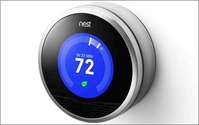Commentary
Forget 'Smart' Devices: Help Me Make A Smarter Me
- by Steve Smith , Staff Writer @popeyesm, January 29, 2014
 At this
week’s Mobile Insider Summit we asked some of our leading mobile agency leads to filter signal from noise in a series we called “Bright Shiny Objects.” I asked them to deliver short
presentations in which they highlighted a hot and hyped category of mobility that they feel really does deserve marketer attention. On Monday, Tim Dunn of Isobar provided a detailed explanation of the
iBeacon technology and all the ways in which it will help transform in-store marketing as well as retail and advertising analytics. Yesterday, Ansible’s Angela Steele explored the Internet of
Things.
At this
week’s Mobile Insider Summit we asked some of our leading mobile agency leads to filter signal from noise in a series we called “Bright Shiny Objects.” I asked them to deliver short
presentations in which they highlighted a hot and hyped category of mobility that they feel really does deserve marketer attention. On Monday, Tim Dunn of Isobar provided a detailed explanation of the
iBeacon technology and all the ways in which it will help transform in-store marketing as well as retail and advertising analytics. Yesterday, Ansible’s Angela Steele explored the Internet of
Things.
One of Angela’s underlying points about the “IoT” future is that it puts marketers into a position of needing to think of themselves less as media buyers and more as service providers. After all, once we begin connecting thermostats, refrigerators, prescription bottles and diabetes monitors to the Web, people are not going to tolerate ads across these channels. Of course, that is what many people said of cell phones back in 2005. But we have to presume that as connectivity becomes even more intimate and interwoven with everyday rituals and appliances, people’s tolerance for intrusion and interruption will plummet.
What that means is that marketers need to think more about what set of services they can provide in tandem with these devices. Our tendency in the last century is to conceive of technology as removing friction and adding convenience. That is the first way we tend to conceive and rationalize gadgetry. But as my wife and I reflected on how and where we wanted our lives enhanced by connectivity (while at poolside here in Captiva), convenience was a much less compelling motive for incorporating these devices into our lives.
Having a range turn itself on an hour before returning home is okay, my wife argued, but it is not that interesting. Refrigerators that have recipe-laden video screens or that ping my cell phone when I need to buy milk are okay concepts, but still not justification enough for embracing new gadgetry.
“If they can help me understand whether I am getting the right nutrition every day, then that would be something,” she says.
In fact, my wife has already seen how a simple running app from Nike can quantify a lifelong passion and ritual of running and thus transform it for her. The data feedback she now gets has changed the way she exercises. It has made her a much more goal-oriented runner than she ever was and even motivated her to enter marathons.
For her, a refrigerator and range that tell her whether she hit her protein needs for the day is much more important than streamlining the weekly shopping.
I suggested that it is in the interconnection among all of the devices that we start to see personal analytics brought to a new service level. Imagine if the same food monitors that delivered caloric and nutrition monitoring were tied to sleep monitors like fitness bands. Now the user could find associations between eating and sleeping -- which foods preceded more and less restful nights, for instance. How about tying that to the thermostat so I can see how my temperature settings in the house may impact other behaviors?
The real service that an Internet of Things can provide is leveraging the intimacy these sensors achieve by delivering greater personal insight. Don’t tell me about “smarter” watches, ovens, thermostats. Tell me how to make a smarter self -- a smarter me.



